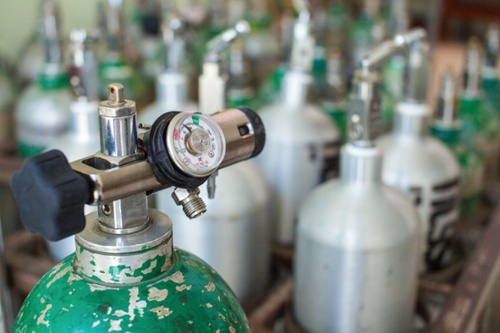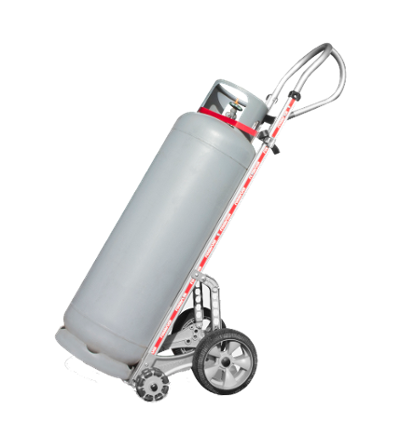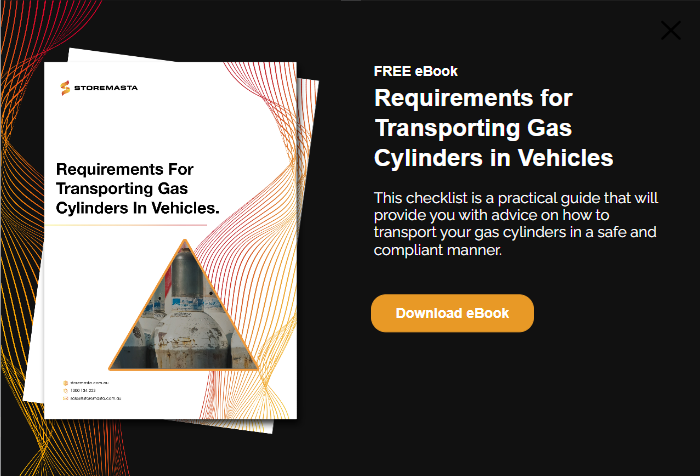When you’re transporting gas cylinders as part of your work duties, you need to exercise extreme caution to ensure that hazards are controlled. Incidents such as fire, toxic gas inhalation or impact damage from flying projectiles, may occur when staff are tasked with transporting gas cylinders.
While dangerous gases are regularly used for a wide range of applications, such as heating, welding, cutting and cooling, the properties of the gas — as well as the pressure within the gas bottle — can create a range of hazards. We’ll look at these 5 major hazards in further detail below.
Hazards
The hazards that are involved with transporting gas bottles are due to two key factors:
- the high pressure within the gas bottle
- the dangerous properties of the stored gas
As an air-like substance, gas will freely expand to fill any space — irrespective of its size. Therefore, gas must be put under immense pressure to be efficiently contained in a small space. To achieve this, gas suppliers force gas into pressurised vessels, called gas bottles, which hold the gas in a liquefied from.

The rapid dispersion of gas can cause a range of hazards from health issues to impact damage from flying projectiles.
Add to this the properties of the gas itself, such as the ability to ignite or release toxic chemicals into the surrounding environment, and you have a range of hazards that you must navigate when transporting gas cylinders.
Some of the major hazards associated with the transportation of gas bottles include highly pressured bottles which could become projectiles, gas leaks which could cause human harm or fires, asphyxiation if the gas is accidentally released, the inhalation of released toxic or corrosive gases, and the rupturing of the gas bottle valve.
We’ll look at each of these scenarios in more detail below.
Gas Bottle Hazard #1: Highly Pressured Bottles
One of the major hazardous associated with transporting gas bottles is the level of pressure inside the vessel. A pressurised gas bottle is normally around 600-800 kPa, which is 3-4 times the pressure inside a car tyre.
With such high pressure, the effects of a ruptured bottle or valve would be immense. In such an event, the gas bottle would turn into a flying projectile, which could cause a lot of property damage, severe injury or even death. A bottle could rupture if the vehicle carrying it becomes involved in an accident or if the bottle fell over from sudden change in direction.
Gas Bottle Hazard #2: Gas Leakage
The dangerous properties of the gas stored inside the bottles is a major transport hazard.
One group of gases that are significantly dangerous are Class 2.1 Flammable Gases. Class 2.1 gases are highly flammable and only 10% of the air inside a vehicle needs to be contaminated with this gas to make an explosive mixture that would readily ignite in the presents of an ignition source.
The most common causes of unexpected gas leakage when transporting gas cylinders includes:
- Bottle valves not closed properly
- Damaged/worn heating equipment still attached to the gas bottles
- Old and brittle hose with unsealed fittings.
There have been a number of events where people have left gas bottles in their vehicles overnight. When they unlocked their vehicle in the morning, via smart lock or manually, it has activated an interior light which worked as an ignition source and caused a catastrophic explosion. These events have killed people and caused immense property damage.
Gas Bottle Hazard #3: Valve Rupture
Another hazard that exists when transporting gas bottles, is the risk of the bottles toppling over.
On the top of each gas bottle is the main valve which the regulator screws into. If the vehicle carrying the gas bottle suddenly stopped or had an accident, the bottles would fall over, increasing the risk of the valve rupturing.
 You can avoid instances of gas cylinder valve ruptures by keeping bottles secured at all times during transit and delivery.
You can avoid instances of gas cylinder valve ruptures by keeping bottles secured at all times during transit and delivery.
If the main valve ruptured, the gas inside the cylinder would rapidly disperse. This could result in the bottle becoming an uncontrollable projectile — which could cause extreme damage to people and property in the area.
To control this hazard, ensure that your cylinders are always kept upright, secured and in the correct method of storage. When moving cylinders from your vehicle to the work premises, ensure that you’re using gas bottle trolleys, such as a Rota trolley, to assist with a safe and seamless delivery.
Gas Bottle Hazard #4: Asphyxiation
There are a number of non-flammable, non-toxic gases that are frequently used for a range of manufacturing process. You may think that a non-flammable, non-toxic gas would be quite safe to transport, however, there have been a number of catastrophic events which have proved them to be quite hazardous.
The biggest risk associated with transporting non-flammable non-toxic gas is asphyxiation. If there is a slow leak in a gas bottle storing non-flammable non-toxic gas, it will slowly replace the oxygen in the air. Oxygen is the life-supporting component of air. If oxygen is depleted, you will start to suffocate, which can lead to unconsciousness and even death.
Gas Bottle Hazard #5: Inhaling Toxic or Corrosive Gas
Transporting gas bottles that contain toxic or corrosive gases can result in the inhalation of dangerous gas, resulting in human harm.
For example, if a gas bottle storing toxic or corrosive gas leaked into the cab of a vehicle, it would have significant effects upon those inside the vehicle. These hazardous effects occur when a person inhales the gas — or the eyes or skin are exposed to the gas.
Depending on the type and volume of toxic/corrosive gas inhaled, victims can experience a range of symptoms.
Symptoms associated with dangerous gas inhalation may include:
- Severe coughing
- Chest tightness
- Respiratory problems
- Acute airway and lung injury
- Death
Some toxic and corrosive gases are colorless, odourless, non-irritating and produce no immediate symptoms. This means that you could become intoxicated by these dangerous gasses without even realizing that they’ve been released.
There are also other corrosive gases, such as chlorine gas, which can send you unconscious after inhaling just a small quantity. If the chlorine gas continued to fill the atmosphere where you went unconscious, it would continue to intoxicate your system, resulting in death.
Therefore, when transporting toxic and corrosive gases, ensure that you take proactive measures to ensure that the gas bottle is sealed and restrained on the outside of the vehicle. By carrying the gas bottle outside of the vehicle, you’ll be able to minimise the risk of gas inhalation.
How to Safely Transport Gas Cylinders
We hope you’ve gained a better understanding of the hazards associated with transporting gas cylinders. From cylinders falling over during transit to the rupturing of valves, there are multiple dangers that must be controlled when you’re working with gas bottles.
If you require a safe method of transporting gas bottles, view our transportable gas bottle trolley which can be used to store and restrain gas bottles on the back of vehicles. Should you require more information on how to safely transport gas bottles, download our free checklist below. Click on the image to get started.
Joining the team as a Dangerous Goods Storage Consultant, Melissa Hampton became Storemasta's Marketing Manager in late 2021. With extensive knowledge and experience in chemical compliance, Melissa is responsible for leading the Marketing team and helping shape their marketing strategy. In her spare time, you can find Melissa hiking, swimming and enjoying the great outdoors in beautiful north-west Tasmania.

